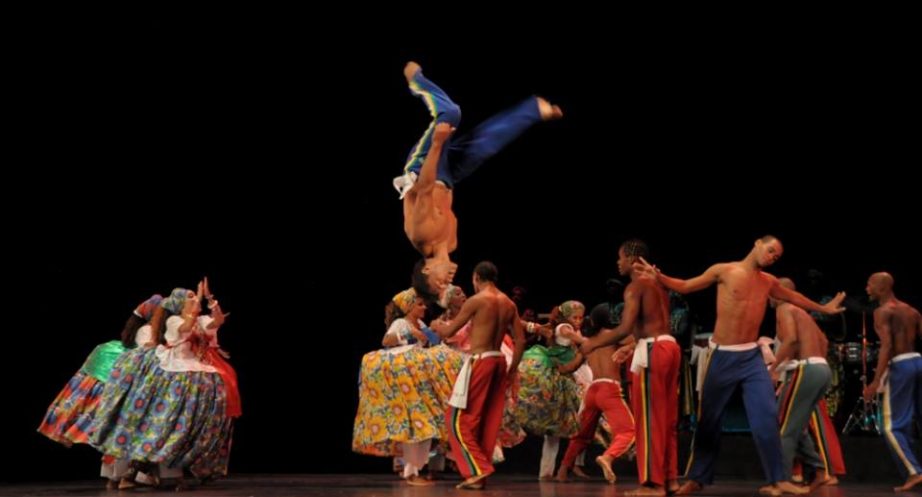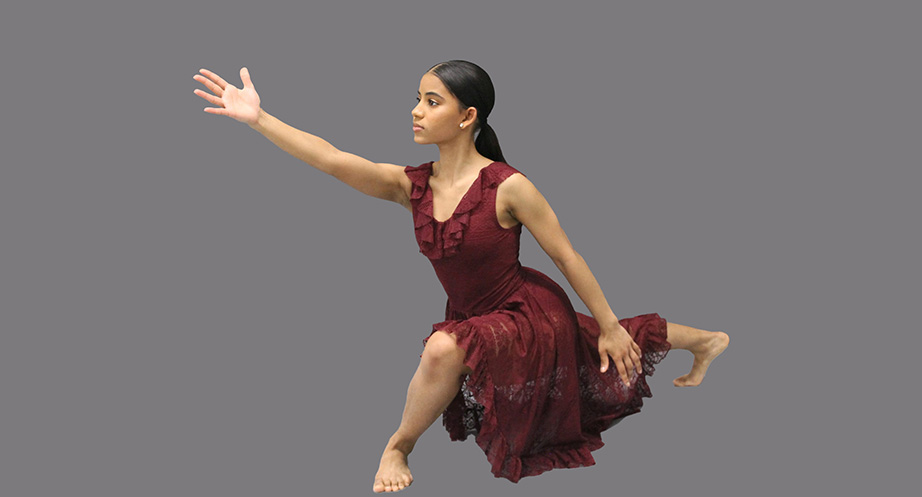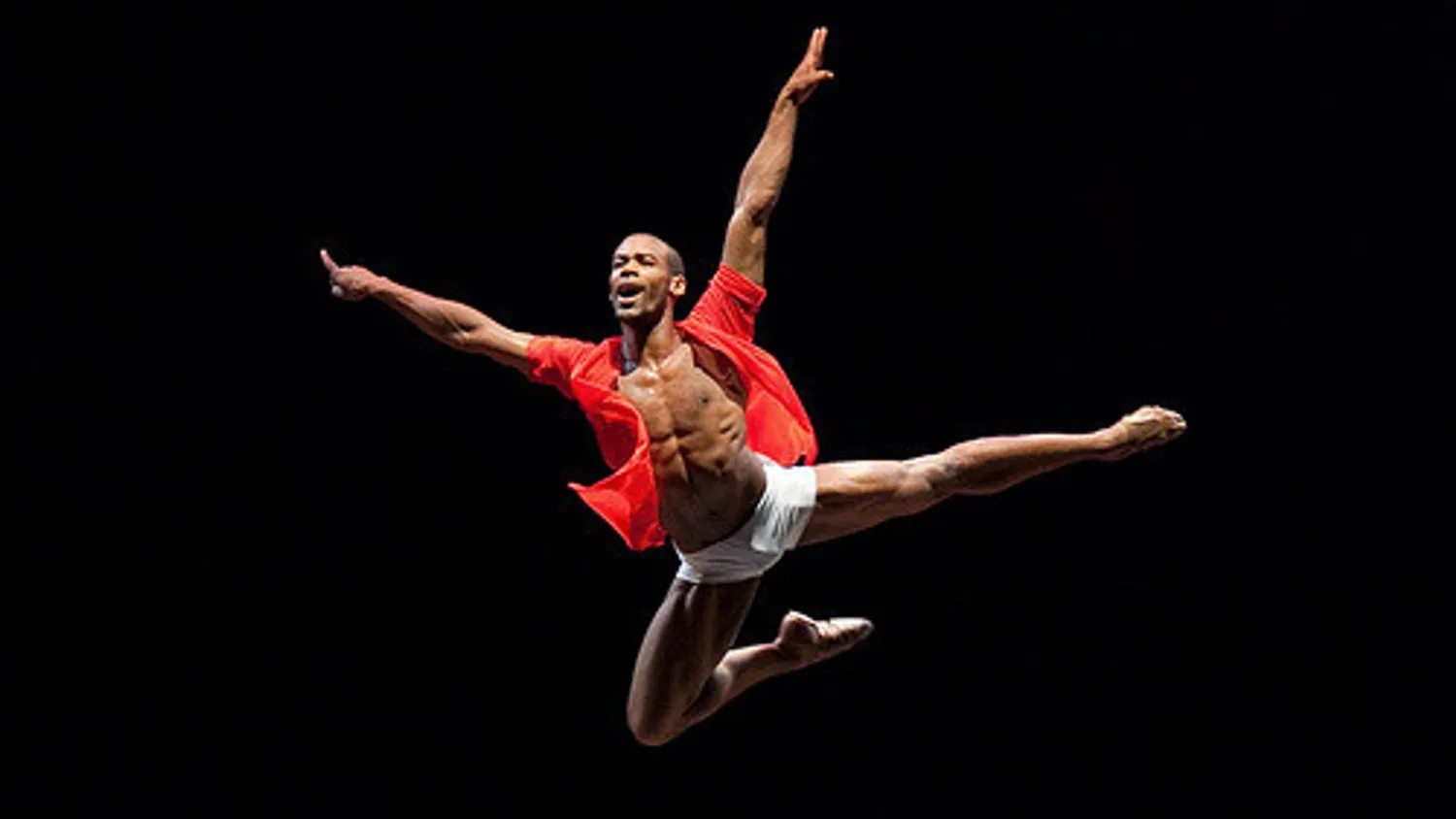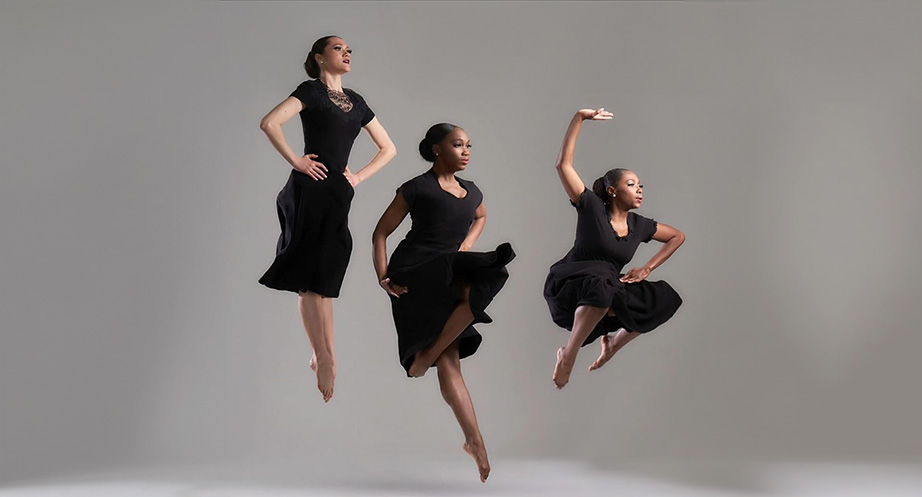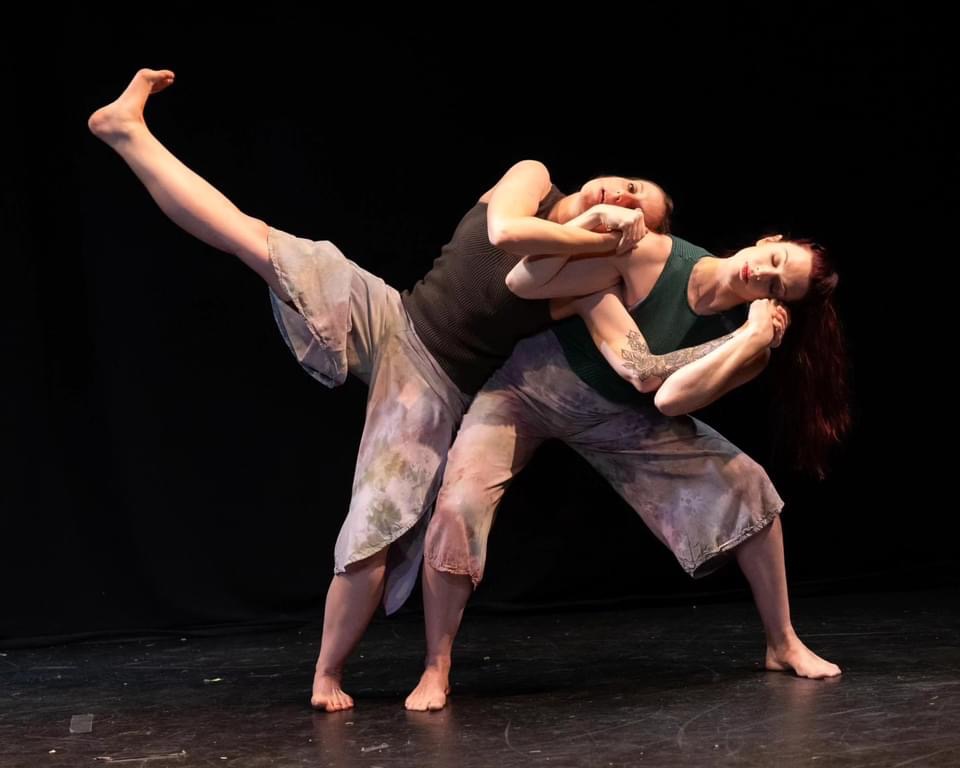by Lewis J Whittington for The Dance Journal | photo courtesy of Bale Folclorico
Balé Folclórico Da Bahia was founded in 1988 by Walson Batelho and Ninho Reis in Salvador, in the northern Bahia region of Brazil. The 32-member company is currently on tour with their repertory show “Bahia of All Colors” and swung into Philadelphia February 17 for an altogether spectacular performance at the Merriam Theater. It had the feel of a happening right from the start with a preview of carnavale and capoeira in the Kimmel’s Commonwealth Plaza, then a processional spilling out onto Spruce & Broad Sts. making their way to the lobby of the Merriam Theater which was already jammed with audience members not wanting to miss a minute.
Latecomers were still filing in when the soundscape and red lights that flooded theater as the singers come down the aisles in a choral invocation led majestically by singer Gilmar Sampaio. Suddenly Sampaio is standing over dancer Yure Meneses just in a black dancebelt, shaking and undulating his torso, then hurtling around a sinewy dance, as other dancers stream on for “Danca De Origem (Origin Dance) depicting the legend of the creation of the universe told by the African religion Candomble, brought to Brazil by enslaved Africans 300 years ago and a dance ritual still practiced in Bahia.
The ensemble streams onstage in white ceremonial the men in white breeches, the women in traditional white hoop dresses, for a dance depicting a supreme being called Oxalá formed the Universe from a mixture of sacred powder. Wagner Santana’s body is painted, his eyes move up and he kneels, trembles, then is still as dancers swirl around him, hoist him up and carry him offstage. The troupe streams back, dance in circles that reach moments of communal transcendence.
Various god characters come forth- Oxum (Goddess of rivers, lakes and waterfalls); Omolu (God of skin diseases, plague, and death); Oxossi (God of forests and hunters) and Oxalá (Supreme God of the pantheon). The Gods move around cryptically but back off for an the central duet by Ednei Cruz, dressed in silver and black warrior toga is Ogun (God of Iron and War) and Aloma Araújo a shredded red fabric costume as Iansã (Goddess of winds and storms), and they electrify as Cruz slices through the air wielding knives, with Araújo the cyclone dancing around him.
‘Puxada De Rede’ (Fishermen’s Dance) Alama Silva slinks onstage a translucent green hoop gown, sea goddess headdress inches over the stage, her arms more fluid than Fokine’s Dying Swan, she is attended by fisherman’s wives, before the ‘Maculelé, the harvest dance, joyously commences with the fisherman leaping and gathering fish with their straw hats. A mise-en-scene tableau brings in a processional under a large parasol with ceremonial dancers carrying earth totems, could have been the choreographic source material later contemporized in a baptismal by Alvin Ailey’s in Revelations.
‘Samba De Roda’ choreographed by Batelha set to traditional Bahain folk music is a raucous carnavale scene that careens in so many dance directions. Two in café suits demonstrate in super-adagio drops, and interlocks of capoeira. The rest of the crowd moves forward ready for a raucous time, the men bare-chested and the women in vivid multi-layered skirts. The music intensifies and the men throw some playful arm and leg jousting, then several fly into a series of explosive acrobatics, double punch fronts and layouts and mach speed somersaults, legs lacerating the air like helicopter blades- degree of difficulty is off the charts. And expressions of carnavale canoodling with lusty gyrations, some bawdy couplings and joyous romantic play.
The bacchanal gives way to thrilling martial arts virtuosity of capoeira, but the scene stealers are the women who start to fight too and the scene turns into a comic brawl, until somebody yells Samba! And it was time to burn the floor.
Throughout the seven dance scenarios, the music is representative of both African and Afro-Brazilian forms, Indigeno (Brazilian natives) and European (Portuguese colonialism) in a fusion delivered by the stellar line of five percussionists who create an engulfing soundfield on congas, kettles, cymbals, timbales and vocal accompaniment by singers Sampaio, Miralva Couto and Dora Santano singing in either Yoruba and Portuguese. Santano’s solo on an inspirational communal ballade, brought the house down, as did conga virtuoso Fabio Santos moved center stage for his improvisational piece on the berimbau, the ancient steely sounding acoustical instrument.
‘Afixirê’ (West African Yoruba for ‘Dance of Happiness’) choreographed by Rosangela Silvestre had the full company, the men in ceremonial multi-colored trousers, The women in vividly colored layered skirts, with neck pieces that only covered their breasts when they weren’t in motion. First the women charge in flanked in geometric lines that continue to get more intricate, then the men come as the music goes to a boil. It is a dazzling display of the sensuality and spirit, in homage to Africa dance Diaspora and its profound influence on Brazilian culture. The thrilling ensemble unison leaps and grounded movement, highlighted by entranced breakout solos by Ednei Cruz, Priscilla Vaz and Tiago Lima, their bodies tapping the torrential rhythms of the drummers, who were indeed, splitting atoms.
“Samba Reggae” is the multi-encored finale choreographed by José Carlos Arandiba and company members set to joyous carnival songs in Afro-Bahian and reggae rhythms that had the audience on its feet and many dancing down the aisles with the company. In an email I received from director Walson Batelho yesterday he noted that “We loved to present Balé Folclórico da Bahia in Philadelphia, that is declared sister city of our town Salvador.” That energy and cultural kinship flowed onstage and off on one transporting dance night to remember.
Mr. Whittington’s arts profiles, features, and stories have appeared in The Advocate, Dance International, Playbill, American Theatre, American Record Guide, The Harvard Gay and Lesbian Review Worldwide, EdgeMedia, and Philadelphia Dance Journal. Mr. Whittington has received two NEA awards for journalistic excellence.
In addition to interviews with choreographers, dancers, and artistic directors from every discipline, he has interviewed such music luminaries from Ned Rorem to Eartha Kitt. He has written extensively on gay culture and politics and is most proud of his interviews with such gay rights pioneers as Frank Kameny and Barbara Gittings.
Mr. Whittington has participated on the poetry series Voice in Philadelphia and has written two (unpublished) books of poetry. He is currently finishing Beloved Infidels, a play about the murder of filmmaker Theo van Gogh. His editorials on GLBTQ activism, marriage equality, gay culture and social issues have appeared in Philadelphia Inquirer, City Paper, and The Advocate.
- A Day in the Life of Philly’s Master Choreographer, Dr. Rennie Harris - March 21, 2024
- Errand Into The Maze | The Life and Works of Martha Graham - March 1, 2024
- Matthew Rushing leads Alvin Ailey Company’s Tour - February 20, 2024

